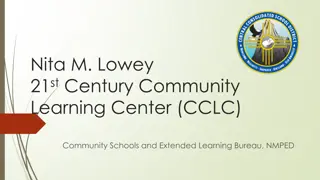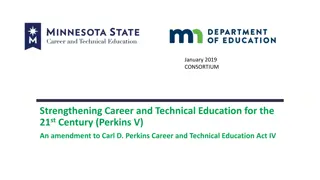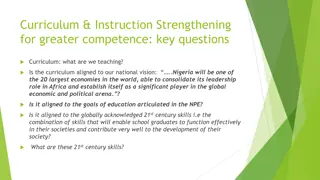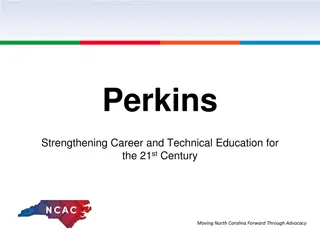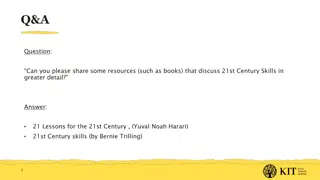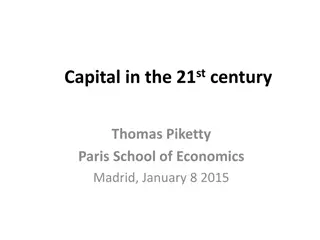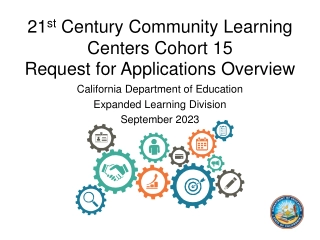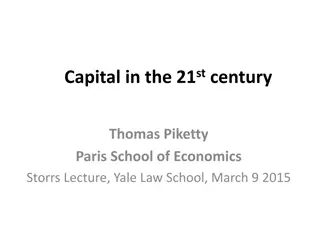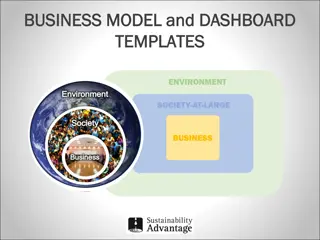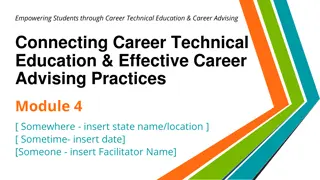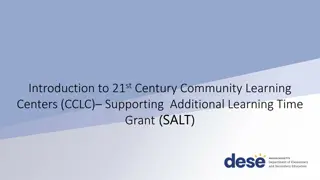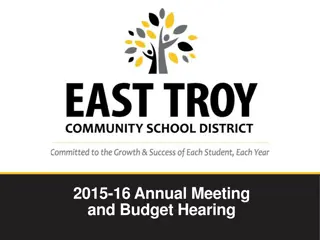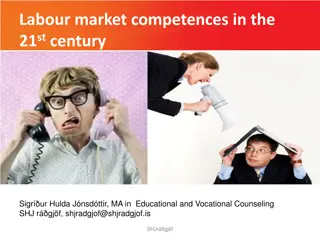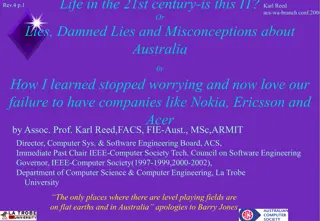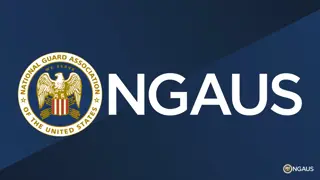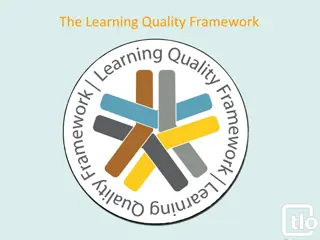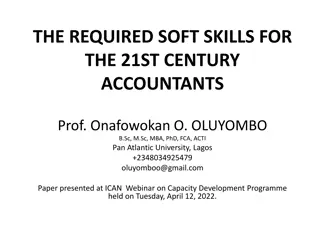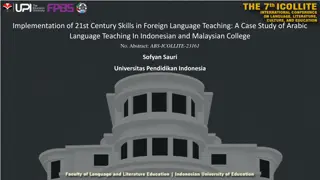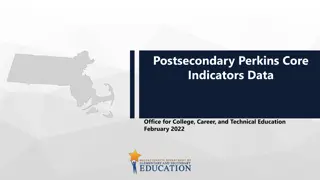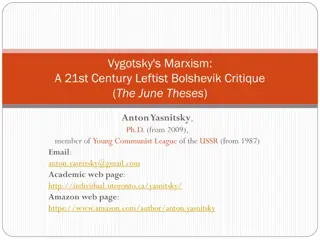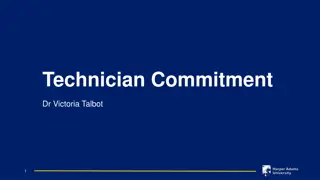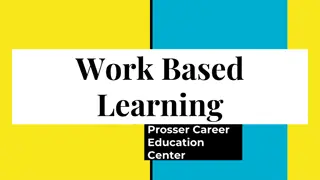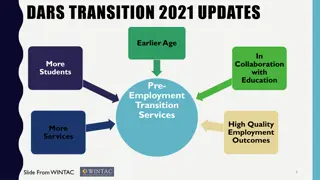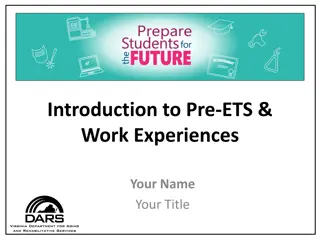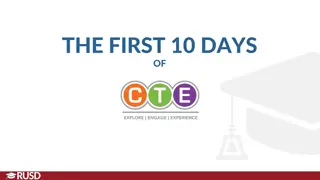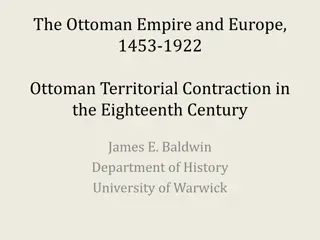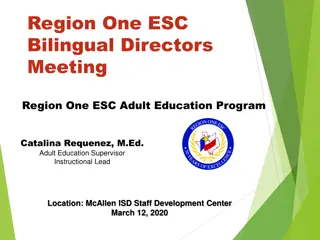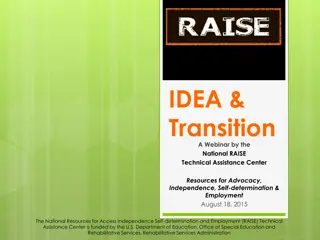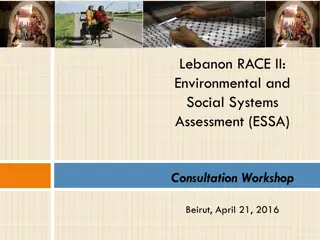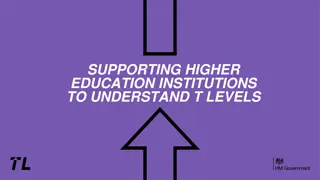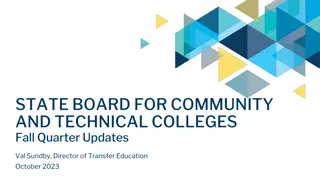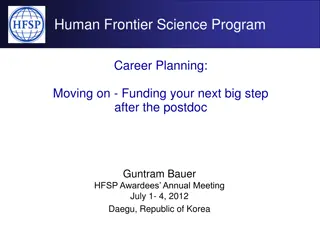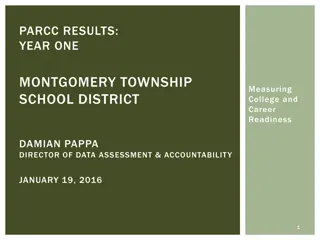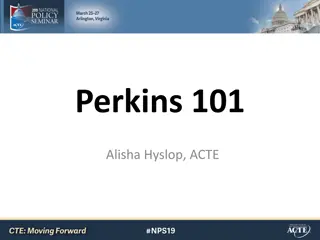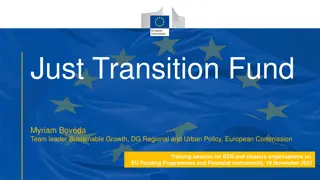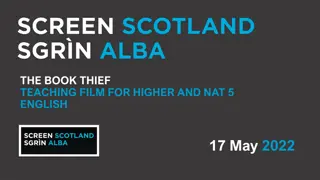Strengthening Career and Technical Education for the 21st Century Transition Plan
The Strengthening Career and Technical Education for the 21st Century Transition Plan in California focuses on improving Career Technical Education (CTE) through state initiatives and investments. It outlines the outcomes, guidelines for submission of state plans, review protocols, and programs of study development to support CTE at the state level, aiming to enhance Perkins V Act for 2019-20. The plan addresses the needs of special populations, fiscal responsibility, and alignment with the state's vision and priorities for CTE.
Download Presentation

Please find below an Image/Link to download the presentation.
The content on the website is provided AS IS for your information and personal use only. It may not be sold, licensed, or shared on other websites without obtaining consent from the author. Download presentation by click this link. If you encounter any issues during the download, it is possible that the publisher has removed the file from their server.
E N D
Presentation Transcript
Strengthening Career and Technical Education for the 21stCentury 2019 20 Transition Plan CALIFORNIA DEPARTMENT OF EDUCATION Tony Thurmond, State Superintendent of Public Instruction STATE BOARD OF EDUCATION Michael Kirst, Ph.D., State Board President CALIFORNIA COMMUNITY COLLEGES CHANCELLOR S OFFICE Eloy Ortiz Oakley, Chancellor
Outcomes Using the Guiding Policy Principles of the California Workforce Pathways Joint Advisory Committee (CWPJAC) and highlighting the state initiatives and investments in Career Technical Education (CTE) we will seek to improve the draft of the Strengthening Career and Technical Education for the 21stCentury Act (Perkins V) 2019 20 Transition Plan in preparation for the submission to Department of Education. 2
Guide for the Submission of State Plans Draft released by the Office of Career Technical and Adult Education (OCTAE) on October 24, 2018. Public comment period ended on December 24, 2018. A second draft was released on February 7, 2019 incorporating some changes suggested during the 60 day comment period. This second draft has a 30 day comment period which ends March 7, 2019. Final guidance should come out by mid April 2019. January 11, 2019 CWPJAC meeting reviewed the three narratives required in the Perkins V Transition Plan Programs, and Programs of Study Meeting the Needs of Special Populations Fiscal Responsibility 3
Protocol for the review of the Perkins V 2019 20 Transition Plan (1 of 2) Review Responses for: Tone Clarity Connection to State vision, and priorities for CTE Responses thoroughly address prompt, without going beyond the requirements 4
Protocol for the review of the Perkins V 2019 20 Transition Plan (2 of 2) After each response, please indicate: Strengths Gaps Questions Recommendations 5
Programs of Study (1 of 11) A. Describe the career and technical education programs or programs of study that will be supported, developed, or improved at the State level, including descriptions of the programs of study to be developed at the State level and made available for adoption by eligible recipients. (Section 122[d][4][A] of Perkins V) 6
Programs of Study (2 of 11) B. Describe the process and criteria to be used for approving locally developed programs of study or career pathways, including how such programs address State workforce development and education needs and the criteria to assess the extent to which the local application under section 132 will i. promote continuous improvement in academic achievement and technical skill attainment; ii. expand access to career and technical education for special populations; and iii. support the inclusion of employability skills in programs of study and career pathways. (Section 122[d][4][B] of Perkins V) 7
Programs of Study (3 of 11) C. Describe how the eligible entities and institutions will: i. make information on approved programs of study and career pathways (including career exploration, work- based learning opportunities, early college high schools, and dual or concurrent enrollment program opportunities), and guidance and advisement resources, available to students (and parents, as appropriate), representatives of secondary and postsecondary education, and special populations, and to the extent practicable, provide that information and those resources in a language students, parents, and educators can understand. 8
Programs of Study (4 of 11) D. facilitate collaboration among eligible recipients in the development and coordination of career and technical education programs and programs of study and career pathways that include multiple entry and exit points; 9
Programs of Study (5 of 11) E. use State, regional, or local labor market data to determine alignment of eligible recipients' programs of study to the needs of the State, regional, or local economy, including in-demand industry sectors and occupations identified by the State board, and to align career and technical education with such needs, as appropriate; 10
Programs of Study (6 of 11) F. ensure equal access to approved career and technical education programs of study and activities assisted under this Act for special populations; 11
Programs of Study (7 of 11) G. coordinate with the State board to support the local development of career pathways and articulate processes by which career pathways will be developed by local workforce development boards, as appropriate; 12
Programs of Study (8 of 11) H. support effective and meaningful collaboration between secondary schools, postsecondary institutions, and employers to provide students with experience in, and understanding of, all aspects of an industry, which may include work-based learning such as internships, mentorships, simulated work environments, and other hands-on or inquiry-based learning activities; 13
Programs of Study (9 of 11) I. improve outcomes and reduce performance gaps for CTE concentrators, including those who are members of special populations (Section 122[d][4][c] of Perkins V). 14
Programs of Study (10 of 11) J. describe how the eligible agency, if it chooses to do so, will include the opportunity for secondary school students to participate in dual or concurrent enrollment programs, early college high school, or competency- based education (Section 122[d][4][d] of Perkins V). 15
Programs of Study (11 of 11) K. describe how the eligible agency will involve parents, academic and career and technical education teachers, administrators, faculty, career guidance and academic counselors, local business (including small businesses), labor organizations, and representatives of Indian Tribes and Tribal organizations, as appropriate, in the planning, development, implementation, and evaluation of its career and technical education programs (Section 122[d][12] of Perkins V). 16
Meeting the Needs of Special Populations (1 of 4) A. describe its program strategies for special populations, including a description of how individuals who are members of special populations i. will be provided with equal access to activities assisted under this Act; 17
Meeting the Needs of Special Populations (2 of 4) A. describe its program strategies for special populations, including a description of how individuals who are members of special populations ii. will not be discriminated against on the basis of status as a member of a special population 18
Meeting the Needs of Special Populations (3 of 4) A. describe its program strategies for special populations, including a description of how individuals who are members of special populations iii. will be provided with programs designed to enable individuals who are members of special populations to meet or exceed State determined levels of performance described in section 113, and prepare special populations for further learning and for high- skill, high-wage, or in-demand industry sectors or occupations; 19
Meeting the Needs of Special Populations (4 of 4) A. describe its program strategies for special populations, including a description of how individuals who are members of special populations iv. will be provided with appropriate accommodations; and v. will be provided instruction and work-based learning opportunities in integrated settings that support competitive, integrated employment (Section 122[d][9] of Perkins V). 20
Fiscal Responsibility (1 of 8) A. Describe the criteria and process for how the eligible agency will approve eligible recipients for funds under this Act, including how i. each eligible recipient will promote academic achievement; ii. each eligible recipient will promote skill attainment, including skill attainment that leads to a recognized postsecondary credential; and iii. each eligible recipient will ensure the local needs assessment under section 134 takes into consideration local economic and education needs, including, where appropriate, in-demand industry sectors and occupations. (Section 122[d][5] of Perkins V) 21
Fiscal Responsibility (2 of 8) B. Describe how funds received by the eligible agency through the allotment made under Section 111 of the Perkins Act will be distributed i. among career and technical education at the secondary level, or career and technical education at the postsecondary and adult level, or both, including how such distribution will most effectively provide students with the skills needed to succeed in the workplace; and ii. among any consortia that may be formed among secondary schools and eligible institutions, and how funds will be distributed among the members of the consortia, including the rationale for such distribution and how it will most effectively provide students with the skills needed to succeed in the workplace (Section 122[d][8] of Perkins V.) 22
Fiscal Responsibility (3 of 8) C. Provide the specific dollar allocations made available by the eligible agency for career and technical education programs and programs of study under section 131(a)-(e) of the Act and describe how these allocations are distributed to local educational agencies, areas career and technical education schools and educational service agencies within the State (Section 131[g] of Perkins V.) 23
Fiscal Responsibility (4 of 8) D. Provide the specific dollar allocations made available by the eligible agency for career and technical education programs and programs of study under Section 132(a) of the Act and describe how these allocations are distributed to eligible institutions and consortia of eligible institutions within the State 24
Fiscal Responsibility (5 of 8) E. Describe how the eligible agency will adjust the data used to make the allocations to reflect any changes in school district boundaries that may have occurred since the population and/or enrollment data was collected, and include local education agencies without geographical boundaries, such as charter schools and secondary schools funded by the Bureau of Indian Education (Section 131[a][3] of Perkins V.) 25
Fiscal Responsibility (6 of 8) F. If the eligible agency will submit an application for a waiver to the secondary allocation formula described in section 131(a) i. include a proposal for such an alternative formula; and ii. describe how the waiver demonstrates that a proposed alternative formula more effectively targets funds on the basis of poverty (as defined by the Office of Management and Budget and revised annually in accordance with Section 673(2) of the Community Services Block Grant Act (42 U.S.C. 9902[2]) to LEAs with the State (Section 131[b] of Perkins V.) Also indicate if this is a waiver request for which you received approval under the prior Carl D. Perkins Career and Technical Education Act of 2006 (Perkins IV). 26
Fiscal Responsibility (7 of 8) G. If the eligible agency will submit an application for a waiver to the postsecondary allocation formula described in section 132(a) i. include a proposal for such an alternative formula; and ii. describe how the formula does not result in a distribution of funds to the eligible institutions or consortia with the State that have the highest numbers of economically disadvantaged individuals and that an alternative formula will result in such a distribution (Section 132[b] of Perkins V.) Also indicate if this is a waiver request for which you received approval under the prior Perkins IV. 27
Fiscal Responsibility (8 of 8) H. Provide the State s fiscal effort per student, or aggregate expenditures for the State, that will establish the baseline for the Secretary s annual determination on whether the State has maintained its fiscal effort, and indicate whether the baseline is a continuing level or new level. If the baseline is new, please provide the fiscal effort per student, or aggregate expenditures for the State, for the preceding fiscal year (Section 211[b][1][d] of Perkins V). 28


